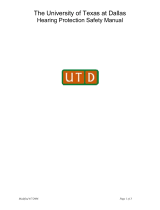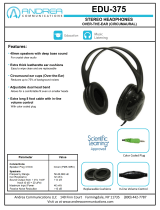
Earmuff Fitting Tips
Contrary to popular belief, earmuffs are
not one-size-fits-all devices. The head-
band may not extend or collapse
enough to fit all head sizes, and cup
openings may not properly accommo-
date the largest ears. The contours in
the circumaural areas of the wearer's
head may be so irregular that the cush-
ions cannot properly seal against them.
Like an earplug, an earmuff must be in-
dividually dispensed and checked for fit
to acquaint wearers with its features and
make sure it is compatible with their
anatomy.
Place the muff on the wearer's head and
be sure the cups fully enclose, and are
centered about the pinnae, without rest-
ing on them. Adjust the headband so that
it sits comfortably on the head and the
cushions feel to the wearer as though
they exert evenly distributed pressure
around the ears. Instruct users about the
importance of achieving the best pos-
sible seal between the earmuff cushions
and the side of the head. Caps and other
head-worn gear must not interfere with
this seal, and excess hair should be
pulled back and out from beneath the
cushions.
Eyeglass temples should fit close to the
side of the head and be as thin as prac-
tical in order to reduce their effect on the
ability of cushions to seal around the ear.
The loss in attenuation that temples cre-
ate, with cushions in good condition, is
normally 3 to 7 dB. The effect varies
widely among earmuffs and also de-
pends upon the fit and style of the eye-
glasses. Representative data are plot-
ted in Figure 4.
E•A•RLog® is a registered trademark of Aearo Company. Copyright 1996. First printing 1988
LIT. CODE 30311 2/99AG
Wearing eyeglasses in combination with
earmuffs may be uncomfortable for some
wearers since earmuff cushions press the
eyeglass temples against the skull. The
pressure can be relieved by fitting foam
pads over the temple pieces, but the in-
crease in comfort may be at the expense
of attenuation as has been demonstrated
for one commercially available pad prod-
uct.
8
Also, pads do nothing to reduce
acoustic leaks caused by overlength
temples which break the cushion-to-skull
seal behind the ear. However, temple pads
should still be considered for use, since
the improved comfort they can provide
may be crucial in motivating certain em-
ployees to wear their HPDs.
Earmuff protection can be roughly
checked by asking wearers to listen with
earmuffs on while in the noisy environ-
ment in which they work. They should be
able to detect a considerable difference
in the overall apparent noise level if they
lift both earmuff cups, or between their two
ears if they lift only one cup. If not, the ear-
muffs were either grossly misfitted, are in
very poor condition, or the noise in which
the persons work is predominated by the
lower frequency sounds for which ear-
muffs generally give less protection. Most
listeners will not be able to detect small to
modest degrees of misfit with this test since
earmuffs will usually provide enough
noise reduction, even when moderately
misfitted, to be clearly distinguishable from
the no-attenuation (i.e. the lifted-cup) con-
dition.
Final Comments
Years of hearing conservation experience
have shown that hearing protectors are
often misused, and that in general their
real-world performance falls far short of
the protection that properly-worn and
maintained HPDs can provide. To improve
the situation, employers must develop ef-
fective group and individual training ses-
sions in which employees are provided
clear and accurate guidance in the fitting
and use of their HPDs. The tips described
herein will be useful in that regard; train-
ing and motivational concepts have been
elaborated elsewhere.
1,3,5,7,9
Remember, it takes time to get used to
wearing protectors, both how they feel and
how they sound. A break-in period is ad-
visable for new wearers, especially in the
case of earplugs. It may take a week or
two for some persons to fully adapt to the
feeling of wearing hearing protectors and
to begin to recognize and appreciate the
auditory as well as the non- auditory ben-
efits that their use provides.
Fitting hearing protectors is largely a com-
mon-sense affair. With time, commitment,
and the experience gained from careful
observation, nearly all ears can be suc-
cessfully fitted and real world problems
overcome.
References
1. Berger, E. H. - The EARLogs, complete series available
upon request from Aearo Company.
2. Royster, L. H. and Royster, J. D. (1985). "Hearing
Protection Devices," in
Hearing Conservation in Industry
,
edited by A.S. Feldman and C. T. Grimes, Williams and
Wilkins, Baltimore, MD, 103-150.
3. Berger, E. H. (1986). Hearing Protection Devices," in
Noise
and Hearing Conservation Manual, 4th edition
edited by E.
H. Berger, W. D. Ward, J. C. Morrill, and L H. Royster, Am.
Ind.Hyg. Assoc., Akron, OH 319-381.
4. Gasaway, D. C. (1984). " 'Sabotage' Can Wreck Hearing
Conservation Programs," Natl Saf. News 129(5), 56-63.
5. Ohlin, D. (1975). "Personal Hearing Protective Devices
Fitting, Care, and Use," U.S. Army Environmental Hygiene
Agency, Report No. AD-021 408, Aberdeen Proving Ground,
MD.
6. Manual (33002) and Roll Model training aid are available from
Aearo Company at the address shown below.
7. Guild, E. (1966). "Personal Protection," in
Industrial Noise
Manual Second Edition
, Am. Ind. Hyg. Assoc 84-109.
8. Berger, E. H. (1986). Unpublished research notes on mea-
surements taken at E-A-RCAL
SM
Laboratory.
9. Royster, L. H. and Royster, J. D. (1986). "Education and
Motivation," in
Noise and Hearing Conservation Manual 4th
edition
, edited by E. H. Berger, W. D. Ward, J. C. Morrill,
and L.H. Royster, Am Ind. Hyg. Assoc., Akron, OH, 383-
416.
FREQUENCY (kHz)
0
125 250 500 1000 2000 4000 8000
Small cup, foam cushion 8 dB
Medium cup, foam cushion 5 dB
Medium cup, liquid cushion 6 dB
Loss in NRR
5
10
LOSS IN ATTENUATION
(dB)
Figure 4. Effects of correctly sized and fitted eyeglasses on the attenuation of three
different earmuffs.
10-subject data re ANSI S3.19-1974
8






